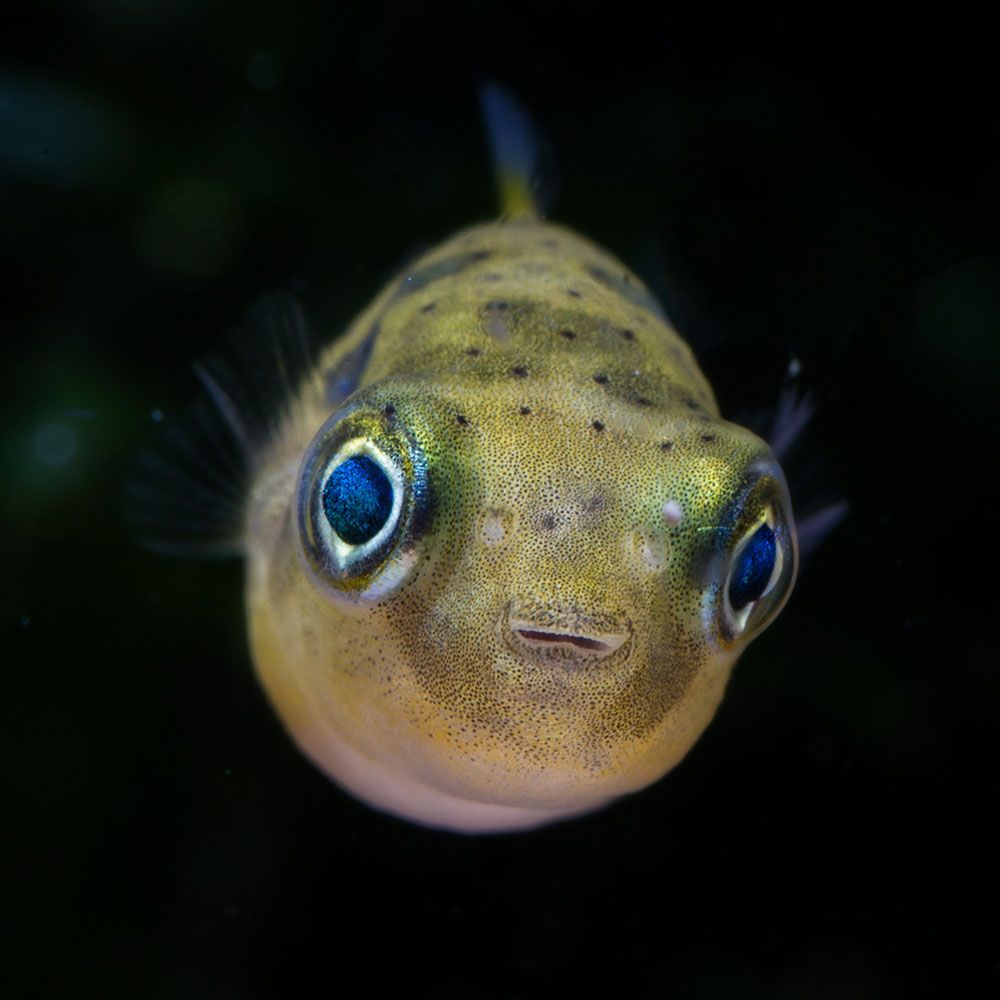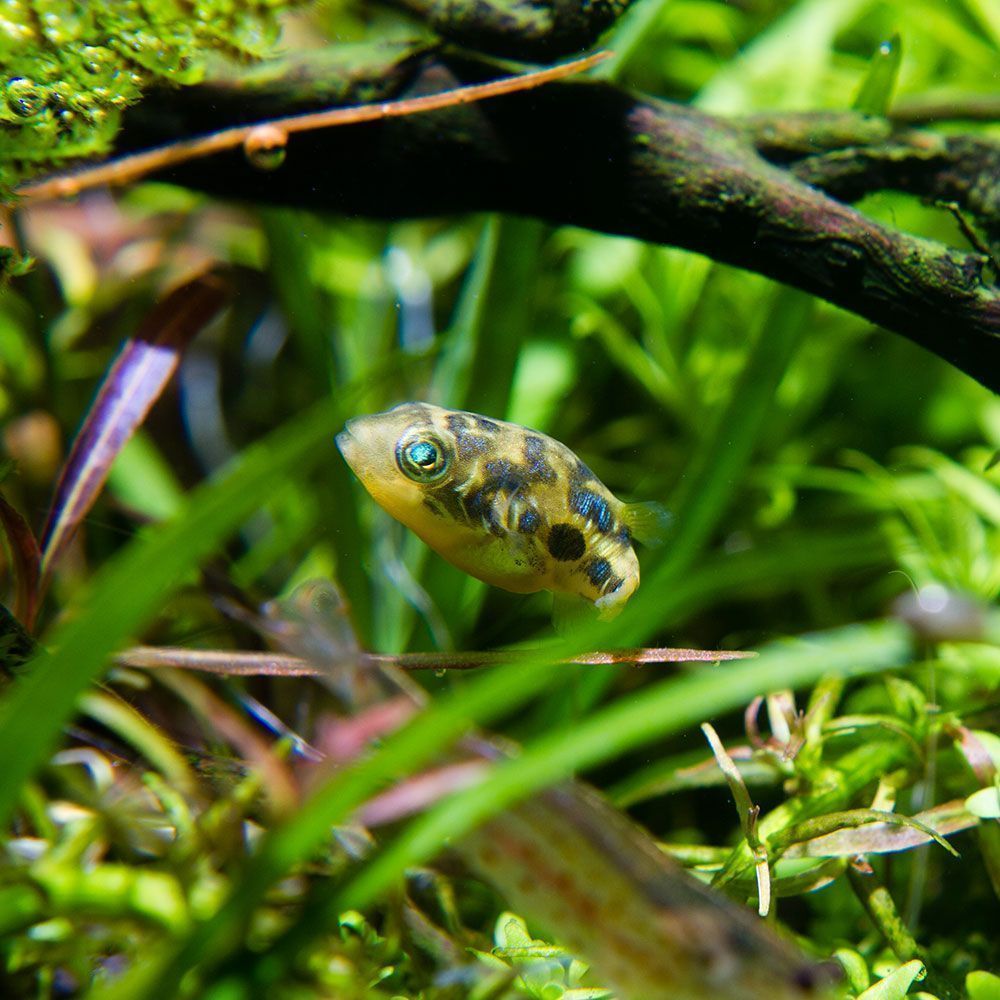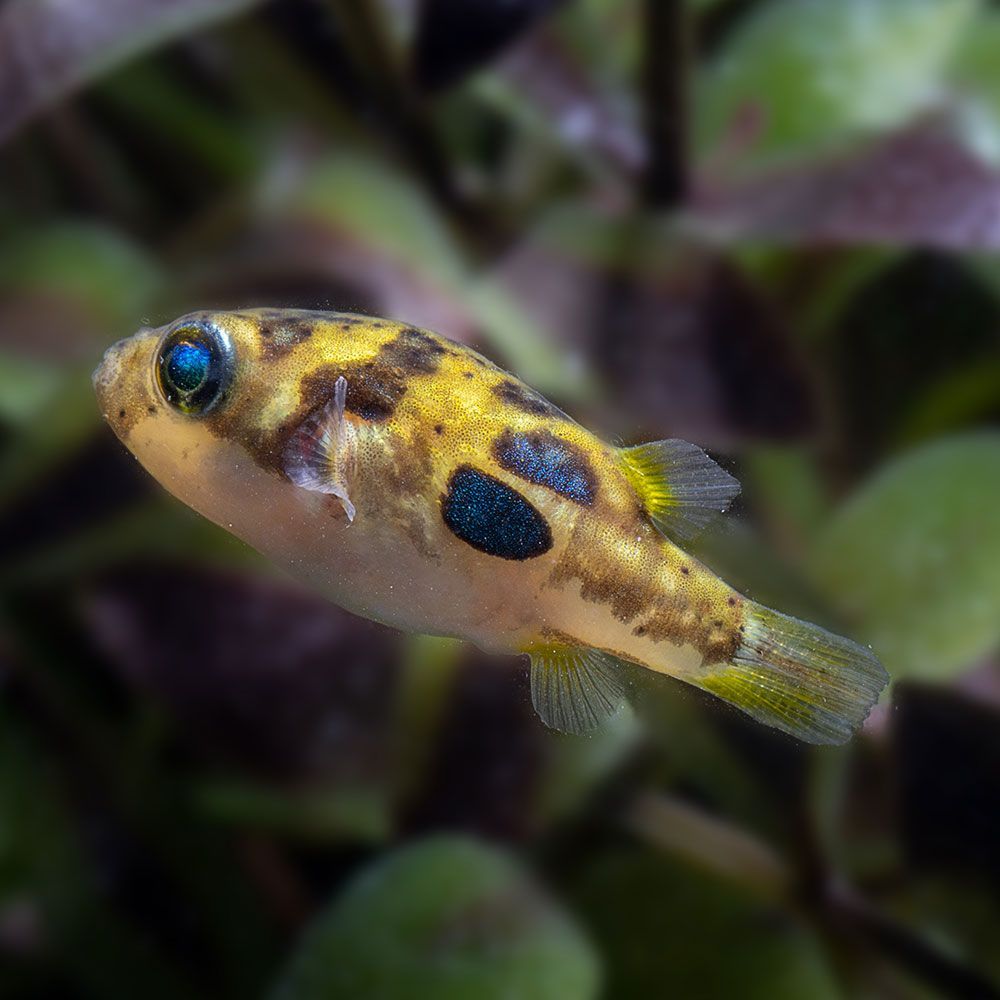Active, sensitive, and beautiful freshwater pea puffer makes a great aquarium fish. Their cute behavior and ability to recognize their owner make them a must-have.
They inflate like tiny water balloons and are easy to care for. They are territorial and pack quite a lot of personality in their little bodies. When scared, they can hide themselves in the substrate.
This article will discuss these little fish, from appearances to breeding and reproduction.
What is a Pea Pufferfish?
A pea puffer fish is a freshwater fish that is popular among several beginner and experienced fish keepers for its capability to recognize its owner.
| Origin | Kerala and Southern Karnataka in Southwest India |
| Order | Tetraodontiformes |
| Family | Tetraodontidae |
| Scientific Name | Carinotetraodon travancoricus |
| Common Names | Malabar pufferfish, pygmy pufferfish, dwarf pufferfish |
| IUCN Red List Status | Vulnerable |
| Appearance | Yellowish-golden body covered with dark iridescent patches along with flanks. Short, fan-shaped pectoral fins with an indent at the tip of the fins. |
| Size | Up to 2.5 cm (0.98 in) |
| Lifespan | Up to 4 years |
| Temperament | Very feisty and aggressive |
| Tank Level | Middle and bottom dwellers |
| Water Temperature | 74 to 82°F (23°-28°C) |
| pH Level | 6.8 to 7.8 |
| Water Hardness | 8 to 15 dGH |
| Care Level | Intermediate |
| Minimum Tank Size | 5 Gallons |
| Tank Environment | Tanks with thick vegetation. Add plants, rocks, caves, and driftwood so the fish can hide. |
| Diet | Omnivore |
| Tank Mates | Best kept solo or with zebra danios, neon tetras, or cherry shrimp |
What is the Natural Habitat of Pea Pufferfish?
Native to India, active pea puffers are found in the states of Karnataka and Kerala. They thrive the best in freshwater lakes and rivers. The natural habitat of this fish species has plenty of rocks, caves, and plants.
Male dwarf pufferfish species live in alkaline water. The ideal temperature for both males and females is 74°F.
In just five years, the population of this fish has decreased by 40% due to habitat loss, pollution, and overfishing to supply the aquarium trade. Thus, IUCN listed them as Vulnerable in 2010.
Which family does Pea Pufferfish belong?
The scientific name for this species is Carinotetraodon travancoricus. It belongs to the Tetraodontidae family and is classified under the order Tetraodontiformes.
The pea pufferfish has some interesting relatives, including figure eight puffer (Tetraodon biocellatus), spotted congo (Tetraodon schoutedeni), and leiodon (Tetraodon cutcutia). These fish species have similar classifications, but they differ in characteristics.
Some common names of these fish are Malabar pufferfish, pygmy pufferfish, and dwarf pufferfish.
Fun Fact: These little fish have translucent caudal fins that make them difficult to see from a distance.
How does a Pea Pufferfish look?

The googly eyes and open rectangular mouths perfectly complement the small bodies of the Malabar puffer. They have pointed heads, expanded middle bodies, and thin dorsal fins. While swimming, they look like oversized peas.
What is the Size of Pea Pufferfish?
This fish species grows no more than 2.5 cm (0.98 in). While it’s small, it can injure other fishes that are four times their size.
What is the Color of Pea Pufferfish?
At first, pea puffers appear brownish and bland in color. But upon further inspection, they appear bright yellow and deep green. These can change their color mainly because of their mood.
What are the Features of Pea Pufferfish?
Their bodies are rotund and thin around the back. They are covered with dark iridescent patches along their dorsal surfaces and flanks. They have four continuously growing teeth, two at the top and two in the lower jaw.
How do male and female Pea Pufferfish differ?
Identifying sexes in pea puffers can be challenging, but you can do it by analyzing the colors.
The male species are brightly colored and have yellow ventral surfaces. They have wrinkles around their eyes and dark stripes down the center of their belly. Females have random black spots throughout their bodies.
How does Pea Pufferfish behave in an aquarium?
These species are highly territorial and aggressive. They are known to attack their kind and other fish species. But their behavior changes over time, especially as they go through several stages of their development.
Males are less aggressive, but they do not injure females. You can keep a pair of pea puffers in a single 8-gallon aquarium to reduce aggression.
What is the Lifespan of Pea Pufferfish?
The average lifespan of this fish species is four years. Better food, care, and a tank environment can increase their life expectancy.
Do not add salt to the water because it can decrease the fish’s lifespan. Monitor the water conditions and keep the water temperature within acceptable limits.
Interesting Fact: While pea puffers do not have scales, they are masters of self-defense. They inflate themselves with water to look much larger than they usually are.
How to take care of Pea Pufferfish?

Are you excited to welcome this magnificent fish into your home? Let’s get into the details to create the perfect aquatic ambiance and know more about their diet, mates, and diseases.
What is the Tank Size for Pea Pufferfish?
Being small fish, they can survive in aquariums under 20 gallons. In my opinion, keep a single fish in a 5-gallon tank, add sufficient hiding spots, and maintain the water quality. Do not overstock the tank, as these species need calm territory.
When adding more fish, increase the tank size by 3 gallons per additional fish to ensure enough space for all of them.
What is the Water Chemistry required for Pea Pufferfish?
Dwarf puffers like to live in neutral freshwater parameters. They are sensitive to water condition fluctuations and cannot survive in polluted water. Here’s how you can replicate their natural habitat in an aquarium.
- pH Levels: 6.5 to 8.0
- Water Temperature: 74 to 82°F (23°-28°C)
- Water Hardness: 8 to 15 dGH
- Ammonia: 0 ppm
- Nitrite: 0 ppm
- Nitrate: Below 15 ppm
Regularly test the tank water quality and make necessary adjustments to maintain a healthy living condition.
What is the Tank Environment for Pea Pufferfish?
The natural habitat of Malabar puffer has shallow and slow-moving water with lots of rocks and plants. Do not add aquarium salt to freshwater puffer aquariums unless it is used to treat diseases.
What Substrate is needed for Pea Pufferfish?
These low-maintenance fish species can survive on any substrate.
The ideal substrate is sand, which is convenient for planting your plants and won’t potentially damage your puffers. You can also use gravel or coarse sand as they facilitate better plant growth. Add a layer of leaf to give a natural look to your tank.
Which Plants are required for Pea Pufferfish?
Background plants like Amazon Swords and stem plants like dwarf ambulia (Limnophila sessiliflora) are great for dwarf puffer tanks. These plants provide sufficient hiding spots and conceal equipment such as filters from view.
To create an engaging tank, add tall plants in one area of the tank and smaller plants in another area.
Floating plants like duckweed (Lemna minor) and water lettuce (Pistia stratiotes) can also be used.
Remember to control the floating plant population, as they can quickly overcrowd the aquarium.
What type of Lighting do Pea Pufferfish prefer?
Pea puffers fancy dim lighting as bright lights can startle them, causing stress. Use the usual aquarium lights in low-lighting conditions.
What type of Decor is needed for Pea Pufferfish?
These tiny fish love exploring and hiding. So, make your tank interesting by adding driftwood, floating plants, rocks, and caves. Your fish will feel more secure and happy in a tiny jungle-like aquarium.
Which Filtration system does Pea Pufferfish need?
Install a powerful tank filter, as these are messy eaters. They are intolerant of poor water conditions. Frequently change water to maintain nitrate level below 15 ppm or as close to zero.
What is the Water Flow Rate for Pea Pufferfish?
Dwarf puffers are not great swimmers and enjoy slow to moderate water flow. Use a powerhead to maintain water circulation and oxygenation in the aquarium.
Interesting Fact: Pea puffers use their eyes independently to spot danger from far away.
What does Pea Pufferfish eat?
Pea puffers are not picky eaters and can easily munch down on any you give them. But it’s better to provide them with a carnivorous diet.
As they have slow-growing teeth, they can survive on live, freeze-dried, and frozen foods. Treat them with molluscs, brine shrimps, and worms, so they receive a good balance of proteins and nutrients.
They also enjoy eating pest snails and fresh seafood.
Feed them twice a day with half a portion each time. But avoid overfeeding.
What are the Tank Mates for Pea Pufferfish?
These fish are famous for nipping the fins of other fish. They can quickly become aggressive toward their tank mates.
If you want to keep 3-4 pea puffers together, start with juveniles, eliminating any aggressive behavior among them. The best way to keep them is to put 2-3 females for a male.
Opt for peaceful, short-finned fish, like otocinclus catfish, corydoras catfish and invertebrates like amano shrimps. These will not compete with the pea puffers for food and will maintain a calm relationship in the tank.
Which Tank Mates to Avoid for Pea Pufferfish?
Do not house this species with aggressive and territorial species. Fishes like guppies, freshwater angelfish, gouramis, bettas, large and aggressive cichlids and barbs are unsuitable tankmates.
What are the Common Diseases in Pea Pufferfish?
| Disease Name | Causes | Symptoms | Treatment |
|---|---|---|---|
| Ich | Parasitic infestations, poor water conditions | White spots on body and fins, flashing, lethargy | Medications with malachite green/formalin, raised water temperature |
| Fin Rot | Bacterial infection, poor water quality | Deterioration of fin tissue, frayed fins, loss of fin color | Antibacterial medications, improving water quality, salt baths |
| Swim Bladder Disorder | Genetics, overfeeding, poor diet | Difficulty swimming, floating upside-down, loss of balance | Adjusting diet, fasting, peas or daphnia to aid digestion |
How to Breed Pea Pufferfish in an Aquarium?
Breeding pea puffers can be done by setting up a separate breeding tank. Add plenty of plants and hiding spots to create a familiar atmosphere for your fish.
Follow these steps to get the most viable fry out of the breeding process:
What Male-to-Female Ratio should be kept for breeding Pea Pufferfish?
Maintaining a ratio of one male for every three females is ideal as it decreases aggression while increasing the chances of successful breeding.
Mating Ritual & Conditioning
Unlike some species, these fish do not have a specific mating ritual. The females deposit about 10 or fewer eggs, and the males select a flat rock or spawning site. If you want to have more eggs, you can keep several females in a tank, as dwarf puffers can spawn every day.
Pea puffer likes laying eggs on moss. In the wild, pea puffers scatter eggs on the base of their river ecosystem. The fish do not possess any parental instincts. So, it’s likely that puffers won’t know that these babies are their own.
Ideal sexual mating development for puffers occurs around 7 or 8 months of age. If your fishes are less than 6 months old, mating them would be difficult.
How to prepare the breeding tank for Pea Pufferfish?
Prepare at least 10 gallons breeder tank with sand substrate, wide leafy plants, driftwood, and slightly warm water. The pH level for water needs to be neutral.
This fish does not require special triggers to breed. But you must feed them a protein-rich diet to promote breeding. Avoid adding pellet or flake foods as they lack the essential nutrients for spawning.
What are the Signs of Pregnancy in Pea Pufferfish?
Identifying whether a female fish is pregnant is difficult, but if you look closely, you can notice the female’s belly becoming rounder.
The eggs are spherical and float on the surface due to their weight. Within a week, babies are hatched. Females prefer to lay their eggs on or near plants such as java moss.
Fry Development & Care
Once the egg hatches and the fry swims freely. Don’t feed babies right after they begin to have their first swim, as the babies have their little yolk sacs to feed on. Also, their mouths are too small to eat anything else. After a few days, you can add extra food like infusoria and baby brine shrimp for the young ones. As they grow bigger, you can start adding larger foods.
Keep in mind organisms like rhabdocoela are a threat to unhatched puffers as they eat fish eggs.
Avoid separating fry from their parents until 6 months. But if you notice signs of aggression in the tank, relocate the fry to a different tank. You can either breed the pair again or transfer them to the main tank.
Breeding Tip: The key to successful breeding is offering this fish species sufficient moss and algae. Add sufficient plants and hiding spots to breed like a pro.
How to Buy Pea Pufferfish?
When purchasing pea puffers from a reputable dealer, choose ones that are brighter, active, and have no signs of illness.
Signs of bad health include white spots on the body, abnormal swimming patterns, and sluggish behavior. Likewise, signs of good health include intact fins and clear eyes.
A word from FishInAquarium
Pea puffers are small in size and easy to take care of. Their interesting personality and adorable looks make them the center of attraction. These are not picky eaters but enjoy carnivorous diets.
We hope you enjoyed reading this post about small fish species. Share it with your aquarist friends and community tanks alike.
Don’t forget to check our other guides for valuable information on your favorite aquarium fish.
Happy fishkeeping!


